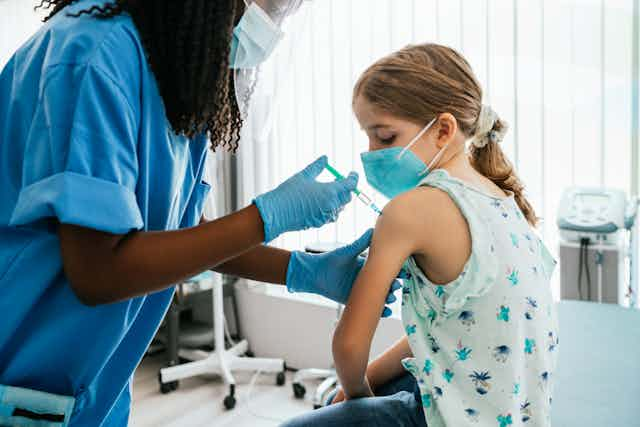COVID-19 case numbers are rising again in the U.S. – including among children. In mid-May 2022, the Food and Drug Administration authorized a booster shot of the COVID-19 vaccine for U.S. children ages 5 to 11, and the Centers for Disease Control and Prevention followed by recommending a booster shot for this age group.
Naturally, many parents are wondering about the importance and safety of a booster shot for their school-age children. Debbie-Ann Shirley, a pediatric infectious disease specialist at the University of Virginia, answers some common questions about COVID-19 and booster shots in kids that she hears in her practice and explains the research behind why booster shots are recommended for children ages 5 to 11.
1. How important is a booster shot for children?
COVID-19 is generally milder in children than adults, but severe disease can occur. As of late May 2022, more than 15,000 children ages 5 to 11 have been hospitalized with COVID-19 and 180 children have died. During the height of the recent winter surge of the highly transmissible omicron variant, 87% of the children in the 5-to-11 age group who became hospitalized with COVID-19 were unvaccinated.
In addition, the rare but serious condition that can follow in the weeks after COVID-19 infection, known as Multisystem Inflammatory Syndrome in Children, or MIS-C, most commonly occurs among children ages 5 to 11. Over 3,800 cases of MIS-C have been reported in that 5-to-11 age group, and 93% of the children who developed this complication were unvaccinated.
For some vaccines – including those for COVID-19 – effectiveness wanes over time. Booster shots help to bolster the immune response. Several childhood vaccines, such as the tetanus and diphtheria vaccines, require booster shots.
COVID-19 boosters have been shown to improve waning protection in adolescents and adults. Side effects are similar to those reported with the initial series. The risk of myocarditis, or heart inflammation – a rare side effect that can occur following COVID-19 vaccination – seems to be less after a third dose than after the second.
2. How well is immunity holding up from the initial COVID-19 shots?
When administered to children 5 to 11 years old, the Pfizer-BioNTech vaccine generated levels of antibody response similar to that in 16-to-25-year-olds in a clinical trial, which was the basis for the FDA’s initial authorization of the shots in October 2021. But studies after the shots were authorized found that vaccine effectiveness rapidly waned in the 5-to-11 age group during the omicron surge. Despite that, the shots continued to be protective against severe disease and hospitalization.
Vaccination has also been shown to be be highly protective against Multisystem Inflammatory Syndrome in Children.
3. Does a third dose make a difference in children?
In a clinical trial, researchers tested the Pfizer vaccine in children 5 to 11 using a 10-microgram booster dose, which is the same dose children received for the primary series and is one-third the dose used for adolescents and adults. When tested among 401 children, no new safety concerns arose, and in the smaller subset of children in which the immune response was tested, the third shot significantly increased antibody responses, including against the omicron variant. Hence, a third dose seems beneficial for boosting immunity in this age group, similar to older age groups.
The booster dose can be given five months or more after the second shot. But as of late May 2022, fewer than one-third of children ages 5 to 11 had received two shots, meaning that only about 8 million school-age children were eligible to start receiving the booster. This could prove an important layer of protection for them and help limit disruptions on schooling and summer activities, particularly as mask mandates have gone by the wayside.
Children with weakened immune systems who were at first authorized to receive three initial doses of COVID-19 vaccine may now also receive a booster shot – or a fourth dose – as soon as three months after their third dose.
4. Is the COVID-19 vaccine safe for kids?
As of late May 2022, more than 18.5 million doses of the COVID-19 vaccine had been administered to children in the 5-to-11 age group. Most COVID-19 vaccine side effects – such as pain at the injection site – have been mild and short-lived in children. Fatigue, headache and muscle aches are other common side effects.
Reports suggest that most cases of myocarditis that follow vaccination typically improve quickly with medicine and rest. Rates of myocarditis have been lower in children ages 5 to 11 than in teens. In any age group, myocarditis is more likely to occur after infection than vaccination.
5. What about the kids under 5?
For parents of kids ages 6 months to 5 years, COVID-19 vaccines are also finally within sight. On May 23, 2022, Pfizer released new data for this age group, stating that three shots generated strong antibody responses, were well tolerated with no new safety concerns and, based on preliminary data, the series was 80% effective at preventing COVID-19 infection. In late April 2022, Moderna released similar data showing that two doses of its vaccine stimulated good antibody responses and were tolerated well by kids under age 6.
The FDA is set to meet in June 2022 to discuss new low-dose formulations of the Moderna and Pfizer vaccines for this group.
If it is authorized by the FDA, the CDC will then provide recommendations on its use for the more than 20 million children ages 6 months to 5 years in the U.S.

